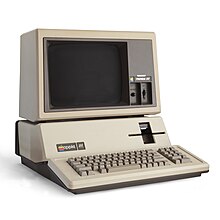Curiosamente, leyendo sobre "Martes 13", me encuentro con:
Uno de los momentos más importantes en la historia del programa fue en 1984 cuando se presentó el comercial "1984", en que se introdujo el computador Apple Macintosh al público chileno, después de casi cuatro minutos de otro anuncio de Apple que tenía una melodía similar al tema de la película Flashdance, y que mostraba los modelos Apple II, Lisa y el nuevo Macintosh.
Por obvias razones el desastroso Apple III (que todavía se estaban vendiendo limitadamente los últimos equipos en Chile por la empresa Computerland) no se mencionó en el programa.[cita requerida]
Y sigo leyendo..
Cómo $%&/()= se les paso de la linea de produccion 14.000 unidades con problemas de ventilacion?
El daño a la reputacion ya estaba hecho.
Orientado a negocios, el precio era $4,340 to $7,800, y dejar el apple II para usuarios y estudiantes.

Supongo que aun asi era incomprable en ese momento economico salvo empresas grandes.
Qué fallo:
1) muy poco tiempo para el desarrollo.
2) Jobs insistió en que no hubiera orificios ni ventiladores, pero el gran problema fue el exceso de calor ... debido a que llego y se fabricaron unidades sin un plan de ingenieria..
En terminos tecnicos, se hizo la base de aluminio de alta resistencia, el cual en teoria disiparia el calor y evitaria las interferencias, problema recurrente.
El protector de la fuente de poder, anti interferencias, no cabia y daba problemas de espacio.
Despues se dieron cuenta de que no habia espacio suficiente en las tarj madres a menos de usar pistas más delgadas.
se uso una tecnolgia llamada Fineline, no madura, en que habia cortocircuitos por lo cercano de las pistas.
Un ingeniero debio diseñar todo en un tablero otra vez y el problema se soluciono.
Se enviaron 1000 unidades hechas a la rapida para los distribuidores. Todas fallaron, hasta los discos de 5.25 se derretian.
Chips soldados a la placa, no faciles de cambiar (como el de reloj de tiempo real).
Basicamente
[spoiler]
Steve Jobs insisted on the idea of having no fan or air vents, in order to make the computer run quietly. Jobs would later push this same ideology onto almost all Apple models he had control of, from the Apple Lisa and Macintosh 128K to the iMac.[19] To allow the computer to dissipate heat, the base of the Apple III was made of heavy cast aluminum, which supposedly acts as a heat sink. One advantage to the aluminum case was a reduction in RFI (Radio Frequency Interference), a problem which had plagued the Apple II series throughout its history.
Unlike the Apple II series, the power supply was mounted – without its own shell – in a compartment separate from the logic board. The decision to use an aluminum shell ultimately led to engineering issues which resulted in the Apple III's reliability problems. The lead time for manufacturing the shells was high, and this had to be done before the motherboard was finalized. Later, it was realized that there wasn't enough room on the motherboard for all of the components unless narrow traces were used.[/spoiler]
Resultados:
Descontinuado en abril del 84, tras 4 meses del III Plus y vender 65,000-75,000 computers and reemplazar 14,000 unidades malas .[27]
Perdieron 100 millones de dolares.
Se los comio el IBM PC y sus clones.
Fallo de marketing: HAcer incaompatible el II para dejar "exclusivo" el III sabiendo que el II se seguia vendiendo cada vez mas.
En ese tiempo se creia que tras 2 años ya el modelo no e iba a vender. [spoiler]
ple has been much maligned for the attention they gave the Apple III project, while suspending all further development on the Apple II. They pegged their chances for the business market in 1980 on the Apple III. Even Steve Wozniak had stated in another interview, "We'd have sold tons of [computers in the business market] if we'd have let the II evolve ... to become a business machine called the III instead of developing a separate, incompatible computer. We could have added the accessories to make it do the business functions that the outside world is going to IBM for."[3] Part of the problem was the immaturity of the entire microcomputer industry at the time. There had never been a microcomputer that had sold well for more than a couple of years before it was replaced by a more powerful model, usually from another company. The Altair 8800 and IMSAI had fallen to the more popular and easier to use Apple II and TRS-80 and Commodore PET, as well as other new machines based on the Intel 8080 and 8088 processors. It is entirely understandable that Apple's attitude between 1978 and 1980 would be of panic and fear that they wouldn't get a new computer out in time to keep their market share and survive as a company. However, during the entire time when Apple was working on the III as a computer to carry the company through until Lisa would be ready, and during the entire time that the Apple II was ignored by its own company, it continued to quietly climb in sales. It is a credit to both the ingenuity of Wozniak in his original design, and to the users of the Apple II in their ingenuity at finding new uses for the II, that its value increased and stimulated yet more new sales. The Apple II "beat" the odds of survival that historically were against it.[/spoiler]
Eramejor revisar el Apple II en vez de lanzar este producto a la rapida.